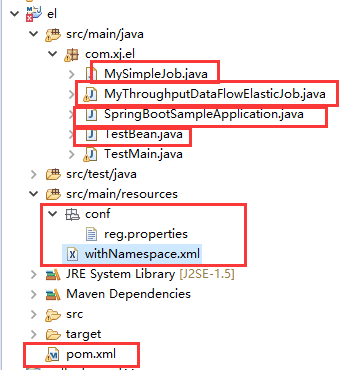Elastic Job 入門
Elastic job是當當網架構師張亮,曹昊和江樹建基於Zookepper、Quartz開發並開源的一個Java分布式定時任務,解決了Quartz不支持分布式的弊端。Elastic job主要的功能有支持彈性擴容,通過Zookepper集中管理和監控job,支持失效轉移等,這些都是Quartz等其他定時任務無法比擬的。
目前Elastic job的最新版本已經由原來的elastic-job-core分離除了兩個項目,分別為Elastic-Job-Lite和Elastic-Job-Cloud。Elastic-Job是一個分布式調度解決方案,由兩個相互獨立的子項目Elastic-Job-Lite和Elastic-Job-Cloud組成,Elastic-Job-Lite定位為輕量級無中心化解決方案,使用jar包的形式提供分布式任務的協調服務。 Elastic-Job-Cloud使用Mesos + Docker(TBD)的解決方案,額外提供資源治理、應用分發以及進程隔離等服務,Elastic-Job-Lite和Elastic-Job-Cloud提供同一套API開發作業,開發者僅需一次開發,即可根據需要以Lite或Cloud的方式部署
開頭copy 網上一段術語,講解的很清晰。總結就是:elastic job 是用來實現 分布式的定時任務,比如說定時任務項目,部署在2臺,但是只需要執行一次,而又想保持2臺服務器代碼都一致,這時候elasitc job 可以很完美的解決問題,當然使用的是zookeeper的相關特性。
1.實戰
項目目錄如下

1.pom.xml
新建maven項目,引入springboot的相關jar包
再引入elastic job 的相關核心包 elastic-job-core,elastic-job-spring
<project xmlns="http://maven.apache.org/POM/4.0.0" xmlns:xsi="http://www.w3.org/2001/XMLSchema-instance"
xsi:schemaLocation="http://maven.apache.org/POM/4.0.0 http://maven.apache.org/xsd/maven-4.0.0.xsd">
<modelVersion>4.0.0</modelVersion>
<groupId>com.xj</groupId>
<artifactId>el</artifactId>
<version>0.0.1-SNAPSHOT</version>
<packaging>jar</packaging>
<name>el</name>
<url>http://maven.apache.org</url>
<properties>
<project.build.sourceEncoding>UTF-8</project.build.sourceEncoding>
</properties>
<parent>
<groupId>org.springframework.boot</groupId>
<artifactId>spring-boot-starter-parent</artifactId>
<version>1.4.0.RELEASE</version>
</parent>
<dependencies>
<dependency>
<groupId>junit</groupId>
<artifactId>junit</artifactId>
<version>3.8.1</version>
<scope>test</scope>
</dependency>
<dependency>
<groupId>org.springframework.boot</groupId>
<artifactId>spring-boot-starter-web</artifactId>
</dependency>
<!-- 引入elastic-job-core核心模塊 -->
<dependency>
<groupId>com.dangdang</groupId>
<artifactId>elastic-job-core</artifactId>
<version>1.1.1</version>
</dependency>
<!-- 使用springframework自定義命名空間時引入 -->
<dependency>
<groupId>com.dangdang</groupId>
<artifactId>elastic-job-spring</artifactId>
<version>1.1.1</version>
</dependency>
</dependencies>
<build>
<plugins>
<plugin>
<groupId>org.springframework.boot</groupId>
<artifactId>spring-boot-maven-plugin</artifactId>
</plugin>
</plugins>
</build>
</project>2.reg.properties
存放zookeeper 配置中心的相關配置信息
serverLists=10.3.142.107:2181,10.3.142.107:2182,106.3.14.107:2183 namespace=elastic-job-example baseSleepTimeMilliseconds=1000 maxSleepTimeMilliseconds=3000 maxRetries=3
3.withNamespace.xml
存放作業的相關詳情,這裏測試存放了 simple 與dataFlow 2中情況。
<?xml version="1.0" encoding="UTF-8"?>
<beans xmlns="http://www.springframework.org/schema/beans"
xmlns:xsi="http://www.w3.org/2001/XMLSchema-instance"
xmlns:context="http://www.springframework.org/schema/context"
xmlns:reg="http://www.dangdang.com/schema/ddframe/reg"
xmlns:job="http://www.dangdang.com/schema/ddframe/job"
xsi:schemaLocation="http://www.springframework.org/schema/beans
http://www.springframework.org/schema/beans/spring-beans.xsd
http://www.springframework.org/schema/context
http://www.springframework.org/schema/context/spring-context.xsd
http://www.dangdang.com/schema/ddframe/reg
http://www.dangdang.com/schema/ddframe/reg/reg.xsd
http://www.dangdang.com/schema/ddframe/job
http://www.dangdang.com/schema/ddframe/job/job.xsd
">
<context:property-placeholder location="classpath:conf/*.properties" />
<!--配置作業註冊中心 -->
<reg:zookeeper id="regCenter" server-lists="${serverLists}" namespace="${namespace}"
base-sleep-time-milliseconds="${baseSleepTimeMilliseconds}" max-sleep-time-milliseconds="${baseSleepTimeMilliseconds}" max-retries="${maxRetries}" />
<!-- 配置作業-->
<job:simple id="mySimpleJob" class="com.xj.el.MySimpleJob" registry-center-ref="regCenter"
sharding-total-count="2" cron="0/3 * * * * ?" overwrite="true" />
<job:dataflow id="throughputDataFlow" class="com.xj.el.MyThroughputDataFlowElasticJob" registry-center-ref="regCenter"
cron="0/10 * * * * ?" sharding-total-count="3" sharding-item-parameters="0=A,1=B,2=C"
process-count-interval-seconds= "10" concurrent-data-process-thread-count="10"/>
</beans>elastic-job提供了三種類型的作業:Simple類型作業、Dataflow類型作業、Script類型作業。這裏主要講解前兩者。Script類型作業意為腳本類型作業,支持shell,python,perl等所有類型腳本,使用不多,可以參見github文檔。
SimpleJob需要實現SimpleJob接口,意為簡單實現,未經過任何封裝,與quartz原生接口相似,比如示例代碼中所使用的job。
Dataflow類型用於處理數據流,需實現DataflowJob接口。該接口提供2個方法可供覆蓋,分別用於抓取(fetchData)和處理(processData)數據。
可通過DataflowJobConfiguration配置是否流式處理。
流式處理數據只有fetchData方法的返回值為null或集合長度為空時,作業才停止抓取,否則作業將一直運行下去; 非流式處理數據則只會在每次作業執行過程中執行一次fetchData方法和processData方法,隨即完成本次作業。
實際開發中,Dataflow類型的job還是很有好用的。
4.MySimpleJob.java
package com.xj.el;
import com.dangdang.ddframe.job.api.JobExecutionMultipleShardingContext;
import com.dangdang.ddframe.job.plugin.job.type.simple.AbstractSimpleElasticJob;
public class MySimpleJob extends AbstractSimpleElasticJob{
@Override
public void process(JobExecutionMultipleShardingContext shardingContext) {
System.out.println(String.format("------Thread ID: %s, 任務總片數: %s, 當前分片項: %s",
Thread.currentThread().getId(), shardingContext.getShardingTotalCount(), shardingContext.getShardingItems()));
}
}5.MyThroughputDataFlowElasticJob.java
package com.xj.el;
import java.sql.Time;
import java.text.SimpleDateFormat;
import java.util.ArrayList;
import java.util.Date;
import java.util.List;
import com.dangdang.ddframe.job.api.JobExecutionMultipleShardingContext;
import com.dangdang.ddframe.job.internal.job.AbstractJobExecutionShardingContext;
import com.dangdang.ddframe.job.plugin.job.type.dataflow.AbstractIndividualThroughputDataFlowElasticJob;
public class MyThroughputDataFlowElasticJob extends AbstractIndividualThroughputDataFlowElasticJob<TestBean>{
public List<TestBean> fetchData(JobExecutionMultipleShardingContext shardingContext) {
List<TestBean> testBeanList = new ArrayList();
//獲取testBean的相關數據
return testBeanList;
}
public boolean processData(JobExecutionMultipleShardingContext shardingContext, TestBean data) {
//處理上文testBean的相關數據
return false;
}
}6.springboot 測試主類 SpringBootSampleApplication.java
package com.xj.el;
import org.springframework.boot.SpringApplication;
import org.springframework.boot.autoconfigure.EnableAutoConfiguration;
import org.springframework.context.annotation.ImportResource;
import org.springframework.web.bind.annotation.RequestMapping;
import org.springframework.web.bind.annotation.RestController;
/**
* Hello world!
*
*/
@RestController
@EnableAutoConfiguration
@ImportResource(locations = {"classpath:withNamespace.xml"})
public class SpringBootSampleApplication
{
public static void main(String[] args) {
SpringApplication.run(SpringBootSampleApplication.class, args);
}
@RequestMapping("/")
String home() {
return "Hello World!";
}
}本文出自 “布拉君君” 博客,請務必保留此出處http://5148737.blog.51cto.com/5138737/1972498
Elastic Job 入門
